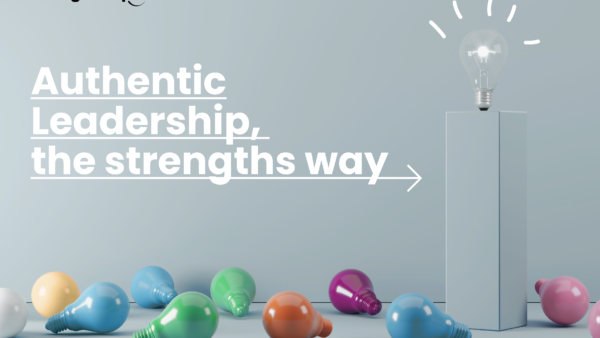How do organisations and the people within them, build their capacity to cope with change, shocks and uncertainty at the same time as dealing with increasing competitive and regulatory pressures that require a higher level of output to even stay in the game?
Evidence is becoming increasingly compelling that building and leading organisations where people are psychologically safe, where they are valued and understood and where their talents and strengths are put to the very best use leads to the most positive organizational outcomes.
Recent research findings show that (based on data from 1.2 million employees in 22 organisations and 45 countries) that 90% of organisations using such an approach reported:

During times of turbulence and change, transitioning to a more positive approach to leadership can feel risky – the default setting for many leaders when the pressure is on is to revert to behaviours which control employees rather than encouraging their creativity and individuality.
And yet it is those organisations who have started to adopt strengths-based principles who are now reaping the rewards.
It would be easy to say that creating a strengths-based organisation is easy to do. It is not. We are talking here about swimming against the strong currents of ‘negativity bias’ that permeate through all areas of our lives. And doing it consistently from this point forward. That’s hard.
Once some basic elements are in place, and these elements will need to be supported and reinforced by leaders, a more positive, open, innovative and resilient culture can start to develop.
So what are these elements and how can you start to build them in your organisation?
Start with your organisation’s purpose
Organisations with a clear, compelling purpose find it easier to recruit and retain people, particularly those who personally relate to that purpose. Organisations need to work to specify their ‘reason for being’, the value the organisation will deliver to customers/end users and how it will behave in the world.
Being clear on your purpose and on how people are contributing to that purpose helps employees to see how they can make a real difference, provided they feel valued and empowered to contribute their strengths, ideas and views in working towards this purpose.
Encourage people to deliver in areas of strength
In strengths-based organisations, leaders encourage employees to discover and use their natural strengths. As we define strengths, these are the ‘underlying qualities that energise them and they are great at or have potential to be great at’ to achieve their objectives.
Employees are not expected to be well-rounded, but rather to grow and excel in areas of their greatest strength. They are also encouraged to call on colleagues for help in areas where they are drained or feel less competent, in itself creating the conditions for collaboration and complementary partnering.
Where employees are falling short in delivering on their objectives, they are encouraged to draw on their strengths to achieve those objectives, also ensuring that they are aware of their weaker areas so that these don’t get in the way of them delivering their best work. Where necessary, these weaker areas can also be developed…up to the point where they have reach an acceptable level.
People in strengths-based organisations are trained in company processes and in the technical skills required for their roles. But more than that, they are encouraged to go beyond their role descriptions and contribute in areas that energise them.
This builds their self-belief and confidence. Gives them the capabilities to succeed and meet their objectives, in a way that works for them, and that has a positive knock-on effect for the culture as a whole.
Empower and enable rather than control
People want the latitude to do their jobs their way without micro-management. Albeit with support and help from their manager when needed. They want the choice as to how the job is performed so they can deal with tasks in a way that suits them best.
Leaders in strengths-based organisations recognise the need to unlock employees’ strengths, ideas, and energy to do their best work. They allow people to make important decisions and back them up with support, coaching and guidance to deal with tougher decisions and get over any roadblocks that may come up.
Leaders in strengths-based organisations adopt a more transparent approach to decision-making and to gaining input from employees, actively asking for suggestions on how work and the workplace might be improved, taking comments and recommendations seriously and communicating back any changes made as a result of staff suggestions. This builds a sense that people’s views are heard and appreciated and a feeling of confidence that they can build a more positive organisation.
Focus on the positives and understand the negatives
Every leader has the choice as to whether to focus on the positives or the negatives in a given situation. The research tells us, and evidence from strengths-based organisations aligns with this, that adopting a positive perspective when appropriate creates the conditions for innovation and improved decision-making (in terms of quality and speed).
When leaders make a conscious choice to focus on strengths, successes, opportunities and solutions, they set off a powerful chain reaction of positive emotions and behaviours.
Maintaining a positive mindset doesn’t mean leaders should fall into the ‘toxic positivity’ trap. A positive mindset doesn’t imply negative emotions should be dismissed or ignored. It highlights the need to surface those emotions and explore the impact on behaviours and results.
So, in strengths-based organisations, if a leader is upset or angry, they are encouraged to talk about these feelings in an open and constructive way and focus on finding solutions with others’ help. This enables them to understand their negative emotions and respond to them appropriately rather than becoming ‘emotionally hijacked’ which can create a negative chain reaction. In the worst cases leading to lowered productivity and a sense of helplessness or giving up.
Manage stress and pressure better
Too many leaders today are pushing their people to breaking point. Stress-related physical and psychological illnesses and instances of ‘burnout’ are on the rise and the cost to both organisations and society are going up and up.
Leaders in strengths-based organisations understand the need to manage stress and pressure – both their own and that of their people. They provide employees with opportunities to rest, reflect and re-energise, encouraging them to fully disconnect in evenings, at weekends and when on leave.
They organise work to ensure people are not working flat out continuously and encourage support networks make sure people have the emotional and practical support they need. These steps help regulate energy, facilitate shared learning from different experiences and enable employees to become more resilient.
Becoming a strengths-based organisation isn’t easy. The five areas of focus above may seem enough in themselves but they are just part of the picture. To create a true ‘SBO’, leaders need to bake the approach into their people processes and that takes time, investment and staying power. But the results are more than worth it.
The time is right for strengths-based organisations and strengths-based leadership. As Tony Hsieh, CEO of online shoe and clothing success story, Zappos, observed:
“…the leader’s role is to free people, not control them – to free their strengths, ideas, energy and value, rather than straightjacketing them with fear, rules and bureaucracy”.
To demonstrate what a strength-based organisation looks like, download the graphic. It will give you a good idea on how what a strengths journey looks like for an organisation.









